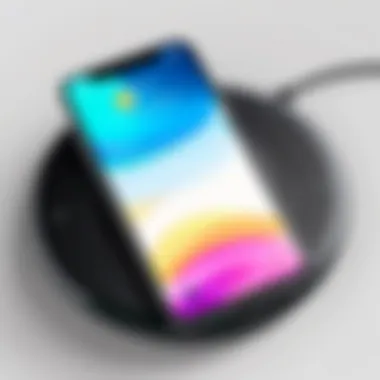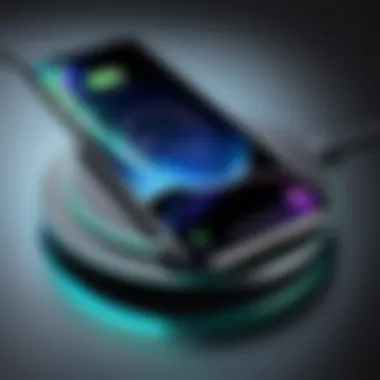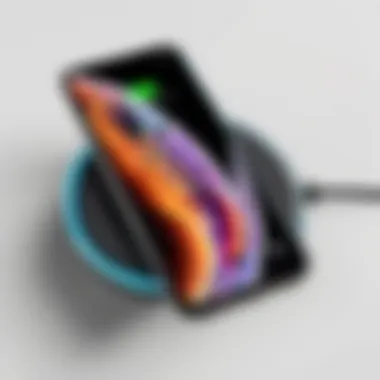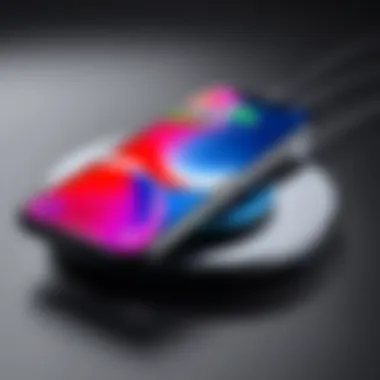Understanding Wireless Chargers for Your iPhone 11


Intro
The proliferation of wireless charging technology has significantly changed how we recharge our devices, providing enhanced convenience and efficiency. This guide aims to unravel the complexities surrounding wireless chargers that are compatible with the iPhone 11. As mobile devices become integral to daily life, understanding the nuances of charging solutions can empower users to make informed decisions.
Wireless chargers use a method known as inductive charging. This technology allows devices to draw power without a physical connection to a charger. With the iPhone 11, Apple has embraced this technology, making it essential for consumers to understand key features and specifications before selecting a charger. Users seek out solutions that not only provide a seamless recharging experience but also comply with safety and performance standards.
In this article, we will outline the technical specifications, compare some of the leading products in the market, discuss practical applications for daily use, explore the latest trends in wireless charging, and provide an informed buying guide. By the end, users will have a clear understanding of what to look for in wireless chargers, helping them enhance their iPhone 11 experience.
Foreword to Wireless Charging
Wireless charging has gained significant traction in recent years, presenting an innovative method for powering devices like the iPhone 11. This technology transforms the way people interact with their electronics, moving away from traditional cables and connectors.
Wireless chargers offer several compelling benefits including ease of use and a reduced risk of wear on charging ports. Understanding how wireless charging works is essential for tech-savvy consumers, gamers, and everyday users. Knowing the technology behind it allows for better product choices and enhances the overall user experience.
Understanding Wireless Charging Technology
At its core, wireless charging employs electromagnetic fields to transfer energy between two objects. The technology primarily hinges on the Qi standard, which is widely adopted.
When an iPhone 11 is placed on an appropriate wireless charger, an inductive coupling occurs. This means that coils in both the charger and the device create a magnetic field that facilitates energy transfer. The iPhone converts this energy into electrical power, recharging its battery without the need for traditional plugs.
A key element of wireless charging technology is its compatibility criteria. Devices must meet specific standards to ensure proper functionality. For iPhone 11 users, seeking chargers that adhere to the Qi standard guarantees seamless interaction and efficiency.
History of Wireless Charging
The concept of wireless charging is not new. It roots lie in the late 19th century when Nikola Tesla demonstrated the principle behind wireless transfer of energy. Over the decades, various technologies emerged but did not gain traction until recently.
The development of Qi, pronounced 'chee', by the Wireless Power Consortium created a foundation for modern wireless charging.
In 2010, the Qi standard was first introduced, leading to wide adoption across multiple device types. Companies began integrating this technology into smartphones, starting a gradual shift from wired solutions. The introduction of models like the iPhone 8 and 11 marked significant milestones in consumer acceptance. As a result, the market expanded, providing a plethora of options to consumers today.
Wireless charging represents a fusion of convenience and innovation, evolving from theoretical concepts into everyday technology.
Compatibility Criteria for iPhone
Understanding the compatibility criteria for the iPhone 11 when it comes to wireless chargers is essential for ensuring optimal performance and efficiency. This device, part of Apple's advanced mobile technology lineup, utilizes specific charging standards and requirements. By recognizing these elements, users can avoid subpar charging experiences and optimize their daily device use. This section will explore various elements, benefits, and considerations crucial for compatible wireless chargers.
Qi Standard Overview
The Qi standard is the backbone of wireless charging technology for the iPhone 11 and many other devices. This standard was developed by the Wireless Power Consortium and has become an industry benchmark. Its design allows for efficient energy transfer between the charger and the device. Using electromagnetic induction technology, the Qi standard ensures seamless communication between the charger and the iPhone 11. This compatibility is key, as it guarantees that users can rely on a wide range of available chargers across different brands.
One of the essential aspects of the Qi standard is its ability to support various power levels. The iPhone 11 can charge at up to 7.5 watts wirelessly, an improvement over previous models. Therefore, when selecting a wireless charger for the iPhone 11, make sure it delivers at least this wattage for optimal charging speeds. Moreover, as this standard continues to evolve, future devices will also likely maintain compatibility, offering longevity to the investment in Qi-enabled products.
Device-Specific Requirements
While the Qi standard sets a universal framework, there are specific device requirements that need consideration. The iPhone 11, as an Apple product, comes with certain expectations, making it vital to ensure the charger aligns with these needs.
- Charging Pad Design: It is crucial to ensure appropriate alignment of the iPhone on the charger pad. Misalignment might lead to slower charging or not charging at all.
- Surface Materials: Some chargers may utilize materials that interact poorly with the iPhone's glass back. Using a charger with a non-slip surface will better support device stability during charging.
- Heat Management: The iPhone 11 is designed with a thermal management system. A compatible wireless charger should not hinder this system, ensuring the phone remains cool during the charging process.
It's advisable to check product descriptions and user reviews before making a purchase. This can provide insights into issues like charging efficiency and suitability for the iPhone 11.
In summary, selecting a wireless charger that adheres to the Qi standard and meets the iPhone 11's specific requirements is imperative. By understanding these compatibility criteria, users can make informed decisions and ensure their device charges efficiently and safely.
Advantages of Using Wireless Chargers
Wireless chargers offer several benefits that make them a popular choice among users of the iPhone 11. As technology evolves, the demand for convenience and efficiency in charging solutions increases. This section explores the specific advantages of using wireless chargers, focusing on usability, ease, and durability.


Convenience and Usability
Wireless charging provides a level of convenience that traditional wired charging cannot match. Users can simply place their iPhone 11 on a compatible charging pad, and the device begins charging without the need for fumbling with cables. This ease of use is especially beneficial for individuals who are often on the go or for those who use their devices frequently.
Moreover, the declining necessity for cable connections minimizes daily frustrations. Forgetting a charging cable at home is no longer an issue as wireless charging pads can be placed in various locations such as offices, homes, or vehicles. This accessibility promotes a seamless user experience. Furthermore, many chargers employ an aesthetic and compact design, making them an appealing addition to any workspace.
Advantages also extend to the charging process itself. Many of these devices feature smart technology that recognizes when the phone is placed on the pad, ensuring an optimal charge is delivered. This feature enhances overall usability while eliminating the guesswork related to proper alignment often encountered with older wireless chargers.
Reduced Wear on Charging Ports
Using a wireless charger can extend the lifespan of your device’s charging port. Continuous connecting and disconnecting of a charging cable can lead to wear and tear on both the cable and the port. This damage may eventually result in connectivity issues or even the need for expensive repairs.
In contrast, wireless charging diminishes dependence on physical connections, thereby reducing the likelihood of such damage. By minimizing friction and strain on the charging port, users can maintain their devices in optimal condition for longer.
The reduced wear on charging ports is particularly advantageous for users who frequently charge their devices throughout the day. For example, gamers and those engaging in demanding activities often need to charge their iPhones multiple times. Wirelessly charging during these high-demand situations can alleviate the risk of port damage.
“Wireless charging is not just a futuristic concept; it’s a practical solution to everyday device maintenance.”
Limitations of Wireless Charging
Wireless charging offers many advantages, but it is essential to understand its limitations as well. This section explores key drawbacks that users may encounter when relying on this technology with the iPhone 11. Understanding these limitations can help users make informed decisions about charging methods and manage their expectations effectively.
Charging Speed Comparisons
Wireless charging typically operates at lower speeds compared to traditional wired charging methods. The iPhone 11 supports wireless charging up to 7.5 watts with Qi-compatible chargers. In contrast, using a wired connection can provide charging speeds up to 18 watts using compatible adapters.
- Faster Options: Wired charging is often preferred for those who need quick top-ups. If you’re in a hurry, it’s advisable to plug in your device rather than rely solely on wireless charging.
- Real-World Implications: Users might find that even longer periods on a wireless charger may not yield significant battery replenishment if they need a rapid charge. In cases where time is crucial, this limitation can pose a challenge.
Heating Issues during Charging
Heat generation is another concern with wireless charging. The process of energy transfer can lead to increased temperatures in both the charger and the device. Though manufacturers implement safety features, overheating remains a notable issue.
- Performance Impact: Excessive heat can negatively impact battery life and performance over time. Users might notice their device getting warm during charging, which could lead to reduced longevity of the battery.
- Best Practices: To mitigate heating, users can ensure proper alignment of the iPhone 11 on the charging pad. Additionally, removing cases that trap heat might provide better thermal management.
It’s crucial for users to weigh the pros and cons of wireless charging to align their needs with their charging habits. Keeping these limitations in mind ensures a more satisfactory experience with this technology.
Safety Features in Wireless Chargers
Wireless chargers have gained popularity due to their convenience, but safety is a critical consideration. Understanding safety features helps consumers make informed choices about their charging devices. Key elements like overheating protection and foreign object detection play significant roles, ensuring the devices function safely and efficiently.
Overheating Protection
Overheating is a common concern with any electronic device, including wireless chargers. As wireless charging delivers power without physical connections, it generates heat. Most modern chargers incorporate some form of overheating protection. This feature typically includes:
- Thermal sensors that monitor temperature levels
- Automatic shut-off mechanisms that stop charging when excessive heat is detected
- Cooling systems like ventilation designs that dissipate heat more effectively
The presence of overheating protection mitigates risks of device damage and enhances longevity. Consumers should look for chargers emphasizing this feature to ensure safer charging experiences. Not only does it protect the device, but it also safeguards the user from potential hazards.


Foreign Object Detection
Foreign object detection is another essential aspect of wireless chargers. This technology identifies any objects that might interfere with the charging process. Examples include:
- Coins
- Keys
- Paperclips
- Cases that do not meet compatibility standards
When a foreign object is detected, many chargers will halt the charging process. This prevents overheating and damage to both the charger and the object. Some advanced wireless chargers emit an audible alert or a visual warning when they find something obstructing the charging area.
The incorporation of foreign object detection in chargers significantly reduces risks and enhances user experience.
In summary, safety features in wireless chargers are crucial to consider. Both overheating protection and foreign object detection contribute to a safer, more reliable charging experience. By prioritizing these elements, consumers can select wireless chargers that better protect their devices and enhance their everyday use.
Factors to Consider When Choosing a Wireless Charger
When selecting a wireless charger for your iPhone 11, there are several important factors to consider. This section will highlight the key elements that influence both the performance and overall user experience of wireless chargers. Making an informed choice will enhance your charging experience and ensure that your device operates effectively with wireless technology.
Charging Speed and Wattage
Charging speed is a critical element when choosing a wireless charger. The iPhone 11 supports wireless charging at up to 7.5 watts. Many wireless chargers on the market boast different wattage ratings, such as 10 watts or even 15 watts. However, it is essential to note that using a charger with higher output does not necessarily increase charging speed for the iPhone 11 beyond its supported 7.5 watts. Therefore, selecting a charger designed specifically for compatibility with Apple devices can maximize efficiency.
Investing in a wireless charger that delivers consistent power output is crucial. The charging speed can be affected by various factors, including the Qi standard, the heat generated during charging, and even the phone case. A quality charger will minimize these variables while providing stable performance.
Additionally, it is advisable to review product specifications from manufacturers, as they often list wattage and charging speed details. Compatibility matters, so ensure your chosen charger aligns with the wireless norms adopted by Apple products.
Design and Form Factor
The design and form factor of a wireless charger can impact both its usability and aesthetics. When selecting a charger, consider its physical dimensions and weight. Some chargers are designed as pads that allow for easy placement of the phone. Others come in stand form, which is beneficial for viewing notifications and using devices during charging.
The material and build quality also play a role. A charger made from durable materials may withstand wear over time, while lighter models may be more portable but could feel less sturdy. Moreover, design elements such as the color and overall style may affect how well the charger fits into your environment.
In addition to these aspects, take into account the cable length and type, as these can influence convenience. A shorter cable may be more suitable for a desk setup, whereas a longer one might be needed for a nightstand.
Choosing a wireless charger that complements your lifestyle can make all the difference in user satisfaction.
Recommended Wireless Chargers for iPhone
Wireless chargers designed for the iPhone 11 hold significant relevance in enhancing the user experience for Apple device owners. Compatibility with the iPhone 11 not only ensures efficient charging but also emphasizes the ease and simplicity that wireless options provide. Users seek reliable chargers that meet specific criteria, such as speed, safety, and overall performance. The optimal choice of charger can reduce wear on ports and maintain device longevity, making the decision both practical and essential.
Apple MagSafe Charger
The Apple MagSafe Charger stands out for its seamless integration with iPhone 11. This charger uses an intelligent design that aligns magnets to ensure perfect placement. As a result, it provides a reliable charging experience. The output is rated at 15 watts, which allows swift charging when matched with a compatible power adapter.
One of the key benefits of the Apple MagSafe Charger is its ability to attach securely to the back of the iPhone 11. This automatic alignment minimizes the hassle often felt with traditional charging pads, where positioning can be an issue. Users appreciate the commitment to quality that Apple consistently demonstrates with its products.
- Fast charging capabilities: Charges the device quicker than standard Qi chargers.
- Safety features: Built-in safeguards protect against overheating and overcurrent.
Anker Wireless Charger


Anker is a well-known name in the charging accessories sector. Their wireless charger offers a reliable charging experience for the iPhone 11. Featuring a sleek design, the Anker Wireless Charger typically supports 10-watt charging for compatible devices, including the iPhone 11. However, it should be noted that when using the iPhone 11, this charger will provide a maximum of 7.5 watts due to device constraints.
Consumers often remark on the design, which is both modern and functional. The non-slip surface keeps the phone securely in place, minimizing the chance of accidental slips that can interrupt the charging process. User reviews often highlight its reliability and decent customer support.
- Universal acceptance: Compatible with various Qi-enabled devices.
- Economic option: A great performance-to-price ratio compared to other offerings.
CHOETECH Fast Wireless Charger
The CHOETECH Fast Wireless Charger brings quality and efficiency together. Rated at 10 watts, it can deliver up to 7.5 watts of power to the iPhone 11. It is equipped with a built-in overheat protection system ensuring user safety during the charging process.
Many users appreciate the design that promotes optimal heat dissipation. This feature helps to keep the device cool, which is important during extended charging periods. Additionally, CHOETECH chargers are often regarded as budget-friendly options, making them accessible for a wider range of consumers without compromising quality.
- Affordable pricing: Offers good performance without a hefty price tag.
- Lightweight and portable: Easy to carry for travel purposes.
The choice of a wireless charger for iPhone 11 is significant, as it enhances usability while maintaining device safety and efficiency.
User Reviews and Experiences
User reviews and experiences play a crucial role in understanding the performance and reliability of wireless chargers for the iPhone 11. Consumers often rely on feedback from others to gauge whether a product meets their requirements. This section will discuss the significance of gathering user insights, focusing on the specific elements that can affect a purchase decision.
User reviews provide real-world context. They reflect the day-to-day experiences of regular users, offering insights that may not surface in promotional content or technical specifications. Positive experiences can highlight the advantages of a wireless charger, while common complaints can shed light on potential issues to be aware of.
Engaging with user reviews can help potential buyers consider various factors, such as charging speed, ease of use, design, and durability. By examining feedback from different consumers, one can make more sacnificed choices, increasing satisfaction and minimizing the risk of disappointment.
Positive Customer Feedback
Positive customer feedback can be highly influential when it comes to selecting a reliable wireless charger for the iPhone 11. Many users express satisfaction over several aspects:
- Usability: Many reviewers appreciate how easy it is to charge their iPhones without needing to plug in a cable. This convenience can make a significant difference in everyday life.
- Design: Users often commend the aesthetics of certain chargers. A good-looking charger may blend well with home or office decor, adding a touch of style.
- Performance: Satisfied customers frequently highlight their successful charging experiences, noting adequate speed and reliable connections. Positive feedback can also include mentions of features like LED indicators that signify if the phone is charging.
Overall, positive feedback often enhances market trust in particular products. It encourages prospective buyers to consider them seriously.
Common Issues Reported
Despite the many advantages of wireless chargers, customers often report specific issues. Understanding these common problems can offer valuable context for potential buyers:
- Charging Speed: Some users express dissatisfaction with slower charging speeds compared to wired options. Complaints about lagging charging times are common.
- Heat Generation: Reports of chargers generating excessive heat while in use are another frequent concern. Consumers worry about the potential impact on battery longevity.
- Positioning Sensitivity: Many users have faced challenges with alignment. If the phone is not precisely placed, charging may fail, leading to frustration.
By considering these common issues, consumers can make more informed choices and understand the potential downsides of wireless charging.
Customer insights serve as an essential resource that helps consumers discern the best options for their specific needs.
Culmination
In this article, we have explored the multifaceted world of wireless chargers that are compatible with the iPhone 11. Understanding wireless charging is not merely about convenience but also about optimizing how we power our devices. A comprehensive grasp of this technology leads to better choices, enhancing both user experience and device longevity.
The key considerations discussed include compatibility, efficiency, safety features, and overall performance. Each of these elements plays a crucial role in determining which wireless charger best suits individual needs. For example, knowing that the iPhone 11 operates under the Qi standard can prevent purchasing a charger that may not work effectively.
When evaluating wireless chargers, paying attention to aspects like charging speed, wattage, and any design preferences is essential. Additionally, safety features such as overheating protection and foreign object detection can safeguard both your device and your peace of mind.
"Investing in a quality wireless charger can prolong the lifespan of your device while enhancing your overall user experience."
Ultimately, the insights provided throughout this article serve to equip readers with the necessary knowledge to make informed decisions. Wireless charging is more than a trend; it represents a shift in how we interact with technology. As we embrace this innovation, understanding its nuances will ensure we are prepared for its benefits, without falling prey to its limitations.







